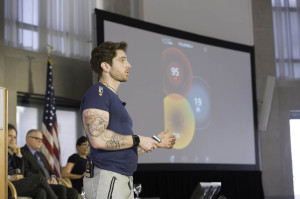
“You absolutely have to have industry partners,” said Claire King, president of Propel LLC, which develops textile-related technologies for protective applications. “Fashion should find good partners for R&D,” said wearable technology expert Despina Papadopoulos, founder of Principled Design/ Studio 50/50. The theme of partnerships and collaborations was repeated often in the Smart Fabrics Summit’s panel discussions. The event was held in Washington D.C. in April and co-sponsored by IFAI and the U.S. Dept. of Commerce.
Specifically, there was a call for more collaboration among the textile, electronics and fashion industries to make smart garments more comfortable and functional—and in more markets. In addition to the top four markets incorporating smart fabric technologies, two more have made significant investments and contributions—and they couldn’t be more different: fashion and medical/health care. Both markets face the challenge of making smart clothing truly wearable.
According to Papadopoulos, communication across disciplines is partly responsible. “To connect these two industries [electronics and textiles] is quite difficult.” However, she said, “Now we have serious interest from people who can make a difference. The environment is changing rapidly.”
Qaizar Hassonjee, senior director of business development and partnerships, adidas, pointed out that there is no “in between” in smart fabrics applications. “It either works or it doesn’t,” he said. Hassonjee feels that there is “a lot of opportunity now to make things right here [in the U.S.].” But he said we also need to “get better at analyzing the data for insights into the consumer” beyond just collecting data and analyzing it.
Another on the same panel, Amanda Parkes, Ph.D., chief of technology and research, Manufacture New York, believes that the industry is “desperately in need of training for workers across industries to be fluent in all the tools.” But she also finds a cultural shift underway in the fashion industry, which has begun to think about developing the fabrics they want and to consider long-range R&D.
Protecting your investment
There was considerable discussion about legal issues that affect technological innovations, including, regulations and standards, patent law, and the challenge of knowing which government agency to contact about specific aspects of an innovative new technology or product. Several panelists contributed to illuminating portions of this large and complicated issue. Lynn Rzonca, a patent attorney with Ballard Spahr LLP, said that when there are layers of technology, “each layer has to be protected.” She also stressed that U.S. patents apply only to the U.S., which offers a one-year grace period after a product announcement not offered by other countries.
She and other panelists stressed the importance of taking reasonable measures early. “Protect early and often,” said Vikrum Aiyer, chief of staff, U.S. Patent and Trademark Office. Lesley Fair, senior attorney with the Federal Trade Commission’s Bureau of Consumer Protection said that it’s also important to build in technology and network security, and to do so early in the process.
E-textiles have special concerns in regards to regulations. Ira Keltz, deputy chief of the Office of the Chief Engineer, Federal Communications Commission (FCC) said, “All devices that radiate energy have to be certified to assure that they’re safe.” Transmitters that are “off the shelf” are already certified.
Alpesh Shah, senior director of Global Business Strategy & Intelligence with the IEEE Standards Association, said that the Internet of Things has been discussed from the electronics side, but it should also be discussed from the actuation side. “This story we’ve been telling is one around convergence,” Shah said.
Medical applications, especially the home monitoring market, are important in a budding segment, showing 7 percent of the 2015 smart fabrics market worldwide. This segment generally faces especially stringent regulations, but standards for smart fabric applications have not progressed much past the discussion stage. It is possible, however, to check standards for the components used, says Sandeep Khatua, director of technical services for softlines, Bureau Veritas Consumer Products Services. Bureau Veritas helps its clients “come up with a testing approach,” he says.
Government agencies stand ready to help in the process of bringing innovations to market. Aiyer told attendees that steps have been taken “to make sure that all tools are used to help entrepreneurs succeed and are protected in the marketplace.” President Obama’s action in this regard makes it a matter of national policy.
Janet Preus is senior editor of Advanced Textiles Source.
 TEXTILES.ORG
TEXTILES.ORG


